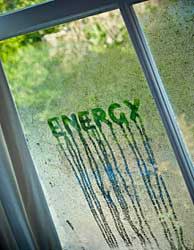An eight-point fall home maintenance checklist
By
Jeff Yeager

More from The Daily Green News blog
Incense, grape Kool-Aid, and a roll of dollar bills: What do these random things have in common? Those are on the shortlist of things you'll need to do a quick home checkup this fall that's likely to save you a roomful of money, not to mention make your home safer and more energy efficient.
Bob Sisson is a friend, fellow cheapskate, and licensed home inspector here in Maryland. I like Bob because he's laid-back and has a good sense of both humor and frugality when it comes to his work.
Here are some nifty DIY tips from Inspector Bob for giving your home a quick once-over this fall, before the winter weather sets in:
1. Try inserting a dollar bill in the gaps around your windows and doors
"If you can do it," Bob says, "then you know exactly where you're money is going -- out the window, due to energy loss."
Simple do-it-yourself repairs can include caulking or installing a variety of inexpensive door/window insulating strips or plastic sheeting. (You can even get help from Uncle Sam on these items, but only until the end of this year.)
[ See all the home improvement tax breaks that expire this year. ]
2. Duct-tape a garbage bag to the basement floor
Check for dampness in the basement. You can tell if moisture is coming in from the outside by duct-taping a garbage bag on the basement floor for 24-hours; if you can see the outline of the bag when you remove it, then you have moisture coming through the concrete.
"Wet basements are often the result of something changing," Bob says. "Many times it's that the gutters have filled up or the downspouts are sending water where it doesn't belong." Now is the time to clean them out and consider installing downspout extensions, which are inexpensive and easy.
3. Check for extraneous extension cords
"Extension cords are for temporary use only," Bob reminds us. "Lots of folks have some out in the yard that have literally 'taken root' or they're using them inside the house on a permanent basis."
Fall is the time to pick up outdoor extension cords and check all cords for potentially dangerous nicks or frayed spots. To store extension cords neatly in the garage or basement, wind your cords around a sturdy 10-inch plastic nursery pot fastened securely to the wall with screws and washers.
4. Smoke out your leaks
"Turn on all of the exhaust fans in the house (including any kitchen fans that vent outside) and put the clothes dryer on the 'air dry' setting," Bob says, as he strikes a match and lights a couple of Mystique Sandalwood incense sticks.
Parading ceremoniously around the house looking more like a shaman than a licensed home inspector, Bob uses the smoke to detect drafts around windows, doors, and other gaps.
[ More DIY home energy audit tips. ]
5. Keep your paints out of trouble
"Old paint should NEVER be stored near the furnace. Big-time fire hazard," Bob says with a disapproving flip of his ponytail. "In fact, why are you keeping it at all?"
Bob suggests peeling the labels off near-empty cans and putting them in a notebook for future reference, or simply writing the color and brand details for the paint used in each room on the back of the light switch-plate there, so you'll have the 411 when you go to repaint.
6. Change your furnace filter
"I get a reminder every month in the mail to change my furnace filter," Bob says with a Johnny Carson-esque pause. "It's called an electric bill."
According to Bob, the fine print on most filters say they last "up to 90 days," but it pays to change them far more often -- even once a month -- during the heating season.
[ Learn these six surprising sources of indoor air pollution. ]
7. Clean your oven filter (with your dishwasher)
And speaking of filters, you know the filter in the hood of your kitchen range, the one that looks like something they've been using to clean up the BP oil spill? Bob says you can just throw it in the dishwasher and it'll be as good as new.
8. Don't forget about the grape Kool-Aid
Pour a package of Kool-Aid (unsweetened, of course) in the toilet tank in the back; if the water in the toilet bowl turns purple without flushing it, then your toilet is leaking and probably needs a new flapper or other seals.
And finally, when was the last time you heard me suggest that maybe it's time to spend a few hundred bucks? Given that it normally takes the jaws-of-life to get the wallet out of my back pocket, the answer is probably never. But this fall is the perfect time to get a home maintenance check-up by a licensed home inspector like Bob, an exercise that will probably set you back about $500 to $1,000, depending on the inspector and the size and type of home.
The good news is, a professional home checkup will probably save you far more than it will cost, and you might just meet a cool guy, like Inspector Bob.
Jeff Yeager is the author of The Cheapskate Next Door and The Ultimate Cheapskate's Road Map to True Riches.
More from The Daily Green:
Reprinted with permission of Hearst Communications, Inc
